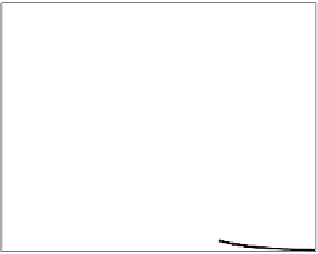Information Technology Reference
In-Depth Information
1
1
f
X|t
f
X|t
0.9
0.9
0.8
0.8
0.7
0.7
0.6
0.6
f
X|−1
f
X|−1
f
X|1
f
X|1
0.5
0.5
0.4
0.4
0.3
0.3
0.2
0.2
0.1
0.1
x
x
0
0
−6
−4
−2
0
2
4
6
8
−6
−4
−2
0
2
4
6
8
(a)
(b)
Fig. 4.5
The lognormal two-class problem for different values of
d
:a)
d
=0
;b)
d
=2
.
Our two-class problem is defined by the following input PDFs
x
√
2
π
exp
x>
0
,
(that is,
μ
=0,
σ
=1)
,
ln
2
(
x
)
2
1
f
X|−
1
(
x
)=
−
(4.41)
f
X|
1
(
x
)=
f
X|−
1
(
−
x
+2+
d
)
(4.42)
where
d
is a non-negative real number, measuring the distance between the
class centers (medians). Figure 4.5 shows this two-class problem for two differ-
ent values of
d
. We focus on the inner intersection as solution to our problem.
Figure 4.6 shows
Q
(
d
) (we omitt the expression as it is rather intrincate) with
its
Q
(
d
)=0solution of
d
=0
.
124. Note, however, that for such small values
of
d
, the Stoller split is no longer at the inner intersection, but at one of the
outer intersections of the class conditional PDFs with a relabel of the classes
(the Stoller split is at the inner intersection with the usual left
ω
−
1
and right
ω
1
order of the classes for
d
0
.
5). That is, as long as the Stoller split is at
the inner intersection, then it corresponds to a SEE minimum.
4.1.3 Empirical SEE Splits
Theoretical SEE splits are only possible to obtain if the class distributions are
known. We now present two methods to empirically deal with SEE when the
class distributions are unknown. The first method uses the KDE estimates
of the input distributions as a means to compute
P
−
1
and
P
1
. The second
method estimates the same quantities directly from the misclassified samples.





































































































